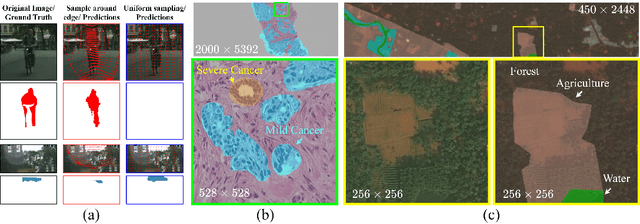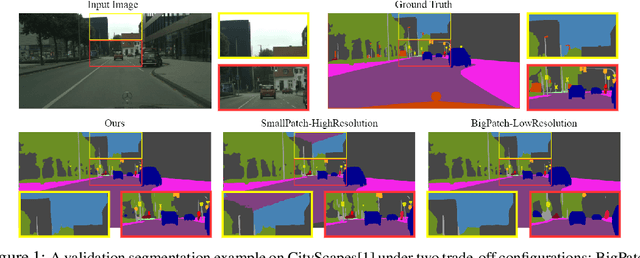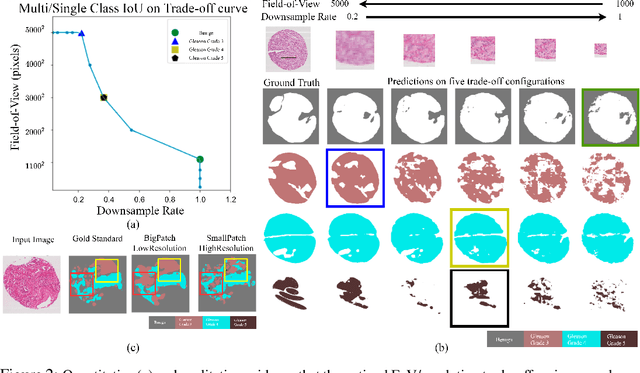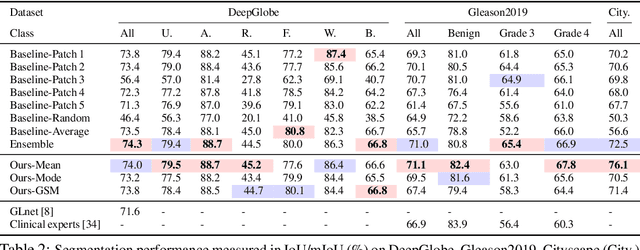Thomy Mertzanidou
Learning to Downsample for Segmentation of Ultra-High Resolution Images
Sep 22, 2021



Abstract:Segmentation of ultra-high resolution images with deep learning is challenging because of their enormous size, often millions or even billions of pixels. Typical solutions drastically downsample the image uniformly to meet memory constraints, implicitly assuming all pixels equally important by sampling at the same density at all spatial locations. However this assumption is not true and compromises the performance of deep learning techniques that have proved powerful on standard-sized images. For example with uniform downsampling, see green boxed region in Fig.1, the rider and bike do not have enough corresponding samples while the trees and buildings are oversampled, and lead to a negative effect on the segmentation prediction from the low-resolution downsampled image. In this work we show that learning the spatially varying downsampling strategy jointly with segmentation offers advantages in segmenting large images with limited computational budget. Fig.1 shows that our method adapts the sampling density over different locations so that more samples are collected from the small important regions and less from the others, which in turn leads to better segmentation accuracy. We show on two public and one local high-resolution datasets that our method consistently learns sampling locations preserving more information and boosting segmentation accuracy over baseline methods.
Foveation for Segmentation of Ultra-High Resolution Images
Jul 31, 2020



Abstract:Segmentation of ultra-high resolution images is challenging because of their enormous size, consisting of millions or even billions of pixels. Typical solutions include dividing input images into patches of fixed size and/or down-sampling to meet memory constraints. Such operations incur information loss in the field-of-view (FoV) i.e., spatial coverage and the image resolution. The impact on segmentation performance is, however, as yet understudied. In this work, we start with a motivational experiment which demonstrates that the trade-off between FoV and resolution affects the segmentation performance on ultra-high resolution images---and furthermore, its influence also varies spatially according to the local patterns in different areas. We then introduce foveation module, a learnable "dataloader" which, for a given ultra-high resolution image, adaptively chooses the appropriate configuration (FoV/resolution trade-off) of the input patch to feed to the downstream segmentation model at each spatial location of the image. The foveation module is jointly trained with the segmentation network to maximise the task performance. We demonstrate on three publicly available high-resolution image datasets that the foveation module consistently improves segmentation performance over the cases trained with patches of fixed FoV/resolution trade-off. Our approach achieves the SoTA performance on the DeepGlobe aerial image dataset. On the Gleason2019 histopathology dataset, our model achieves better segmentation accuracy for the two most clinically important and ambiguous classes (Gleason Grade 3 and 4) than the top performers in the challenge by 13.1% and 7.5%, and improves on the average performance of 6 human experts by 6.5% and 7.5%. Our code and trained models are available at $\text{https://github.com/lxasqjc/Foveation-Segmentation}$.
 Add to Chrome
Add to Chrome Add to Firefox
Add to Firefox Add to Edge
Add to Edge